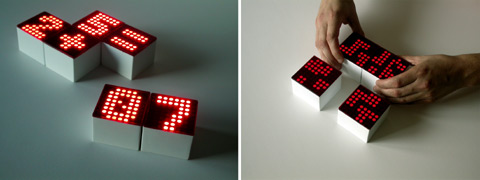TileToy (FI/UK)

Project by Tuomo Tammenpää (FI) and Daniel Blackburn (UK)
Presentation:
Kiasma seminar room // Fri 31 March 11:00 // free entrance
TileToy is a modular, electronic game prototype for tangible LED game tiles. TileToy brings the flexibility inherent in digital software to a physical tile that people can touch and interact with. By arranging the electronic tiles, players can engage themselves in various kinds of game play, ranging from fast-paced arcade style games to puzzle an learning games.
The tiles are plastic cases approximately 2″ square. The main inspiration for the look and feel comes from the heyday of the LED, when plastic hand-held games ruled the gaming world. This retro-look is fused with a more modern minimal design. The minimalism enhances the magic of cordless boxes that simply communicate with each other. In TileToy, technology is sealed within the design. The interaction is based on tactile experience where no user manual is needed.
The flexible architecture of the tiles makes TileToy a versatile platform for development of various applications from several genres. Compared with traditional tile games TileToy can take advantage of such things as changing state, animations and games where the tiles can effect the state of adjoining tiles. Simple word games can be created where each tile displays a random letter and the players organize the letters into the longest word possible. Numbers and arithmetic characters can be displayed with the player having to arrange the tiles into a sum to give a specified result. Matching games are yet another way the tiles could be programmed to act as a learning aid. Applications can be developed also to utilize the tiles purely for display purposes to show patterns, animations or even live information.
The re-programmable and constantly updated graphical information on each tile is displayed with a LED matrix system. The screen displaying the information is an endlessly versatile surface for updated visual communication. Each tile is controlled individually and can be used to transmit information on its own or in groups of several tiles. The assembled tiles transmit wirelessly their individual position in relation to each other and based on that changing information, a central computer, or a dedicated tile runs the different applications.
TileToy is an open project. Both the source code and the hardware is available via open licenses. This will allow anyone interested to create their own applications and games and feed these back into the community hopefully to spark innovation further. It may even lead to new projects that branch off to make new version of TileToy based on the original hardware. The TileToy process is available from the blog: http://tiletoy.blogspot.com